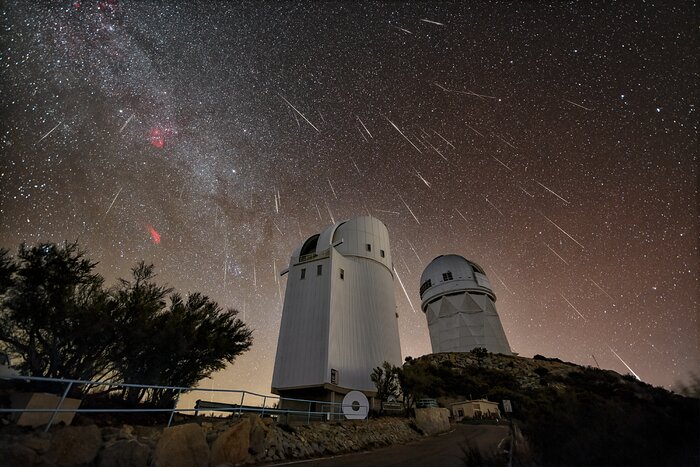Fuegos artificiales cósmicos sobre Kitt Peak
En las afueras de Tucson, Arizona, la lluvia de meteoros de las Gemínidas ofrece su espectáculo cósmico anual, llenando el cielo nocturno de rayas de luz sobre el Observatorio Nacional Kitt Peak de la Fundación Nacional de Ciencias de EE.UU., un Programa de NOIRLab de NSF. Una lluvia de meteoros ocurre cuando la Tierra atraviesa un área del espacio que contiene los restos de un cometa o un asteroide. Estos escombros residuales se queman cuando atraviesan nuestra atmósfera y forman rayas luminosas en el cielo llamadas meteoros. ¿Y qué son los meteoritos? Son los trozos de material que no se desintegraron por completo en la atmósfera y cayeron en la superficie terrestre. Los cielos despejados de Arizona no sólo hacen que sea un lugar ideal para la observación de lluvias de meteoros, sino que su entorno desértico conserva mejor los meteoritos en el suelo. En regiones más húmedas, los meteoritos se desintegran más rápido, pero el aire seco de Arizona y la poca frecuencia de las lluvias permiten que permanezcan intactos y que sean más fáciles de descubrir. Al ser un lugar ideal para encontrar meteoritos, Arizona cuenta con una gran comunidad de coleccionistas de meteoritos, lo que hace que sean muy comunes en la colección de meteoritos de muchas instituciones de investigación.
Créditos:KPNO/NOIRLab/NSF/AURA/R. Sparks
About the Image
| Id: | iotw2424a |
| Idioma: | es |
| Tipo: | Photographic |
| Release date: | 12 de Junio de 2024 a las 12:00 |
| Size: | 5496 x 3670 px |
Sobre el Objeto
| Nombre: | Geminid meteor shower |
| Categoría: | Solar System |
